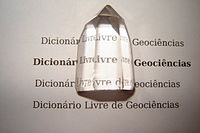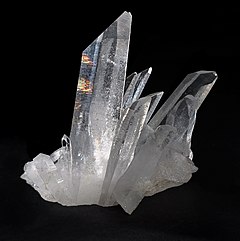QuartzFor other uses, see Quartz (disambiguation).
Quartz (from German Crystal habitQuartz belongs to the rhombohedral crystal system. The ideal crystal shape is a six-sided prismterminating with six-sided pyramids at each end. In nature quartz crystals are often twinned, distorted, or so intergrown with adjacent crystals of quartz or other minerals as to only show part of this shape, or to lack obvious crystal faces altogether and appear massive. Well-formed crystals typically form in a 'bed' that has unconstrained growth into a void, but because the crystals must be attached at the other end to a matrix, only one termination pyramid is present. A quartz geode is such a situation where the void is approximately spherical in shape, lined with a bed of crystals pointing inward. VarietiesPure quartz, sometimes called clear quartz, is colorless or white and transparent (clear) or translucent. Common colored varieties include citrine, rose quartz, amethyst, smoky quartz, milky quartz, and others. Quartz goes by an array of different names. The most important distinction between types of quartz is that of macrocrystalline (individual crystals visible to the unaided eye) and the microcrystalline orcryptocrystalline varieties (aggregates of crystals visible only under high magnification). The cryptocrystalline varieties are either translucent or mostly opaque, while the transparent varieties tend to be macrocrystalline. Chalcedony is a cryptocrystalline form of silica consisting of fine intergrowths of both quartz, and its monoclinic polymorph moganite.[2] Citrine"Citrine" redirects here. For other uses, see Citrine (disambiguation). Citrine is a variety of quartz whose color ranges from a pale yellow to brown. It is nearly impossible to tell cut citrine from yellow topaz visibly. Citrine has ferric impurities, and is rarely found naturally. Most commercial citrine is in fact artificially heated amethyst or smoky quartz. Brazil is the leading producer of citrine, with much of its production coming from the state of Rio Grande do Sul. Citrine is one of three traditional birthstones for the month of November. Rose quartzRose quartz is a type of quartz which exhibits a pale pink to rose red hue. The color is usually considered as due to trace amounts of titanium, iron, or manganese, in the massive material. Some rose quartz contains microscopic rutile needles which produces an asterism in transmitted light. Recent X-ray diffraction studies suggest that the color is due to thin microscopic fibers of possibly dumortierite within the massive quartz.[3] In crystal form (rarely found) it is called pink quartz and its color is thought to be caused by trace amounts of phosphate or aluminium. The color in crystals is apparently photosensitive and subject to fading. The first crystals were found in a pegmatite found near Rumford, Maine, USA, but most crystals on the market come from Minas Gerais, Brazil..[4] Rose quartz is not popular as a gem - it is generally too clouded by impurities to be suitable for that purpose. Rose quartz is more often carved into figures such as people or hearts. Hearts are commonly found because rose quartz is pink and an affordable mineral. AmethystAmethyst is a popular form of quartz that ranges from a bright to dark or dull purple/violet color. Smoky quartzSmokey quartz is a gray, translucent version of quartz. It ranges in clarity from almost complete transparency to a brownish-grey crystal that is almost opaque. Milky quartzMilk quartz or milky quartz may be the most common variety of crystalline quartz and can be found almost anywhere. The white colour may be caused by minute fluid inclusions of gas and/or liquid trapped during the crystal formation. The cloudiness caused by the inclusions effectively bars its use in most optical and quality gemstone applications.[5] Major varietiesAlthough many of the varietal names historically arose from the color of the mineral, current scientific naming schemes refer primarily to the microstructure of the mineral. Color is a secondary identifier for the cryptocrystalline minerals, although it is a primary identifier for the macrocrystalline varieties. This does not always hold true.
Synthetic and artificial treatments A synthetic quartz crystal grown by the hydrothermal method, about 19 cm long and weighing about 127 grams. Not all varieties of quartz are naturally occurring. Prasiolite, an olive colored material, is produced by heat treatment; natural prasiolite has also been observed in Lower Silesia in Poland. Although citrine occurs naturally, the majority is the result of heat-treated amethyst. Carnelian is widely heat-treated to deepen its color. Due to natural quartz being so often twinned, much of the quartz used in industry is synthesized. Large, flawless and untwinned crystals are produced in an autoclave via the hydrothermal process; emeralds are also synthesized in this fashion. While these are still commonly referred to as quartz, the correct term for this material is silicon dioxide. OccurrenceQuartz is an essential constituent of granite and other felsic igneous rocks. It is very common insedimentary rocks such as sandstone and shale and is also present in variable amounts as an accessory mineral in most carbonate rocks. It is also a common constituent of schist, gneiss, quartzite and othermetamorphic rocks. Because of its resistance to weathering it is very common in stream sediments and in residual soils. Quartz occurs in hydrothermal veins as gangue along with ore minerals. Large crystals of quartz are found in pegmatites. Well-formed crystals may reach several meters in length and weigh hundreds of kilograms. Related silica mineralsTridymite and cristobalite are high-temperature polymorphs of SiO2 that occur in high-silica volcanic rocks.Coesite is a denser polymorph of quartz found in some meteorite impact sites and in metamorphic rocks formed at pressures greater than those typical of the Earth's crust. Stishovite is a yet denser and higher-pressure polymorph of quartz found in some meteorite impact sites. Lechatelierite is an amorphous silicaglass SiO2 which is formed by lightning strikes in quartz sand. History Quartz crystal showingtransparency. The name "quartz" comes from the German "Quarz", which is of Slavic origin (Czech miners called itkřemen). Other sources insist the name is from the Saxon word "Querkluftertz", meaning cross-vein ore.[6] Quartz is the most common material identified as the mystical substance maban in Australian Aboriginal mythology. It is found regularly in passage tomb cemeteries in Europe in a burial context, eg. Newgrange orCarrowmore in the Republic of Ireland. The Irish word for quartz is grian cloch, which means 'stone of the sun'. Roman naturalist Pliny the Elder believed quartz to be water ice, permanently frozen after great lengths of time. (The word "crystal" comes from the Greek word for purity.) He supported this idea by saying that quartz is found near glaciers in the Alps, but not on volcanic mountains, and that large quartz crystals were fashioned into spheres to cool the hands. He also knew of the ability of quartz to split light into a spectrum. This idea persisted until at least the 1600s. In the 17th century, Nicolas Steno's study of quartz paved the way for modern crystallography. He discovered that no matter how distorted a quartz crystal, the long prism faces always made a perfect 60 degree angle. Charles Sawyer invented the commercial quartz crystal manufacturing process in Cleveland, Ohio, United States. This initiated the transition from mined and cut quartz for electrical appliances to manufactured quartz. Quartz's piezoelectric properties were discovered by Jacques and Pierre Curie in 1880. The quartz oscillatoror resonator was first developed by Walter Guyton Cady in 1921.[7] George Washington Pierce designed and patented quartz crystal oscillators in 1923.[8] Warren Marrison created the first quartz oscillator clock based on the work of Cady and Pierce in 1927.[9] PiezoelectricityQuartz crystals have piezoelectric properties; they develop an electric potential upon the application ofmechanical stress. An early use of this property of quartz crystals was in phonograph pickups. One of the most common piezoelectric uses of quartz today is as a crystal oscillator. The quartz clock is a familiar device using the mineral. The resonant frequency of a quartz crystal oscillator is changed by mechanically loading it, and this principle is used for very accurate measurements of very small mass changes in thequartz crystal microbalance and in thin-film thickness monitors. | ||||||||||||||||||||||||||||||||||||||||||||||||||||||||||||||||||||||||||||||||||||
Sunday, July 19, 2009
Quartz
Subscribe to:
Post Comments (Atom)
Followers
Blog Archive
-
▼
2009
(61)
-
▼
July
(61)
- Malachite
- Sodalite
- Lapis Lazuli
- Dumortierite
- Benitoite
- Vesuvianite
- Prehnite
- Diopside
- Amblygonite
- Dioptase
- Kyanite
- Variscite
- Fluorite
- Smithsonite
- Sphalerite
- Chrysocolla
- Cerussite
- Serpentine
- Ulexite
- Howlite
- Onyx
- Tufa
- Orbicular jasper
- Alabaster
- Coral
- Ivory
- Amber
- Rhodochrosite
- Labradorite
- Feldspar
- Hematite
- Zoisite
- Nephrite
- Jade
- asper
- Agate
- Chrysoprase
- Chalcedony
- Chrysoberyl
- Amethyst
- Quartz
- Spodumene
- Tourmaline
- Zircon
- Grossular
- Spinel
- Aquamarine - A quality stone
- Beryl
- Corundum
- Sapphire
- Ruby
- Turquoise
- Topaz
- Opal
- Peridot
- Pearl
- Emerald
- Diamond
- "Beryl"
- Amethyst
- Garnet
-
▼
July
(61)













Do you know what is the birthstone for June? Did you know there exist different gemstones for different months? June-born people are lucky because they get to choose between the three June birthstones- Pearl, Moonstone, and Alexandrite.
ReplyDeleteParaiba tourmalines were first discovered in the late 1980’s in Brazil. Since its discovery, this gemstone has taken the world by storm with its neon blues and greens. Paraiba tourmalines appear in a range of greenish blue, bluish green, green, blue and violet hues. In the world of Danyal Paraiba, a brand dedicated to one of the rarest, most valuable, and visually striking gemstones in the entire world.
ReplyDelete